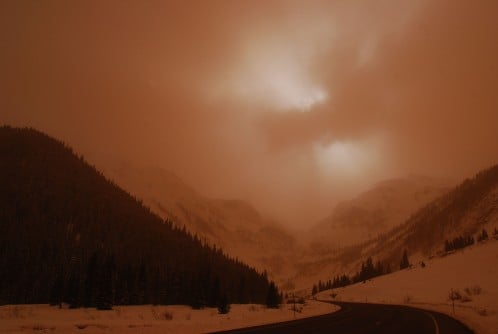Red dust blowing onto pristine white mountain snow might seem like little more than a visual curiosity, but this phenomenon is dramatically reshaping water supplies throughout the Southwest. New research reveals how this dust-darkened snow is accelerating snowmelt in the Colorado River Basin, potentially worsening the region’s ongoing water crisis.
In the first comprehensive study of its kind, University of Utah researchers analyzed 23 years of satellite data to track how dust affects snowmelt across the entire Colorado River headwaters. Their findings, published in Geophysical Research Letters, show that dust significantly speeds up snowmelt every spring—even in years with relatively low dust deposition.
“It’s not just how much dust gets deposited over a season, but also the timing of dust deposition that matters,” said Patrick Naple, doctoral candidate at the University of Utah and the study’s lead author. “Dust is very effective at speeding up melt because it’s most frequently deposited in the spring, when days are getting longer and the sun more intense. Even an extra millimeter per hour can make the snowpack disappear several weeks earlier than without dust deposition.”
The research team found that during high-dust years, the darkening effect can add up to 10 millimeters of additional snowmelt per day—essentially turbocharging the natural melt process. This acceleration is most intense in the central and southern Rocky Mountains at mid-alpine elevations, where the bulk of the Colorado River’s water originates.
What makes this finding particularly significant is that current water management models don’t account for dust’s impact on melt rates. This oversight results in predictions that consistently underestimate how quickly snowmelt will occur and reach downstream reservoirs.
“The degree of darkening caused by dust has been related to water forecasting errors. The water comes earlier than expected, and this can have real world impacts—for example if the ground is still frozen it’s too early for farmers to use,” explained McKenzie Skiles, associate professor at the University’s School of Environment and co-lead author of the study. “If we can start to build dust into the snowmelt forecast models, it will make water management decision-making more informed.”
The study uncovered an unexpected pattern—dust impacts were slightly lower in the latter half of the study period (2014-2023) compared to the earlier years (2001-2013). This finding surprised researchers who anticipated that ongoing drought conditions would increase dust emissions.
Human activity appears to be a significant factor in dust levels. “We know from sediment core records that dust deposition in this area skyrocketed following modern settlement of the West. That tells us that the level of dust we see today is directly related to human activity,” said Skiles.
The research comes at a critical moment for the Colorado River system, which supplies water to 40 million people across seven U.S. states and Mexico. With the river already overtaxed and facing continued pressure from climate change and growing populations, understanding factors that affect water supply timing becomes increasingly crucial.
For water managers throughout the Southwest, this new dataset offers hope for more accurate forecasting—potentially helping communities better adapt to a future where every drop of this precious resource counts.
If our reporting has informed or inspired you, please consider making a donation. Every contribution, no matter the size, empowers us to continue delivering accurate, engaging, and trustworthy science and medical news. Independent journalism requires time, effort, and resources—your support ensures we can keep uncovering the stories that matter most to you.
Join us in making knowledge accessible and impactful. Thank you for standing with us!

